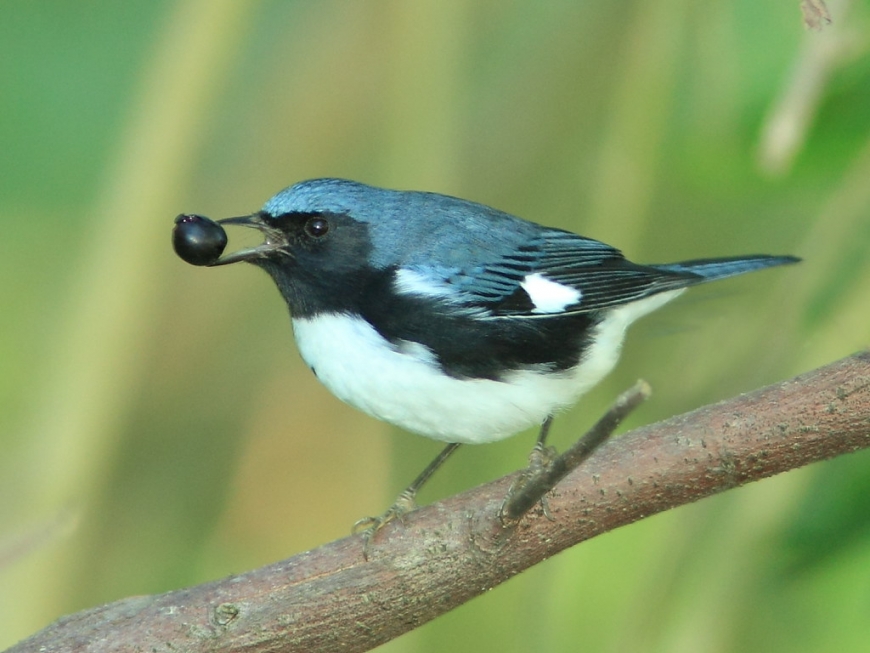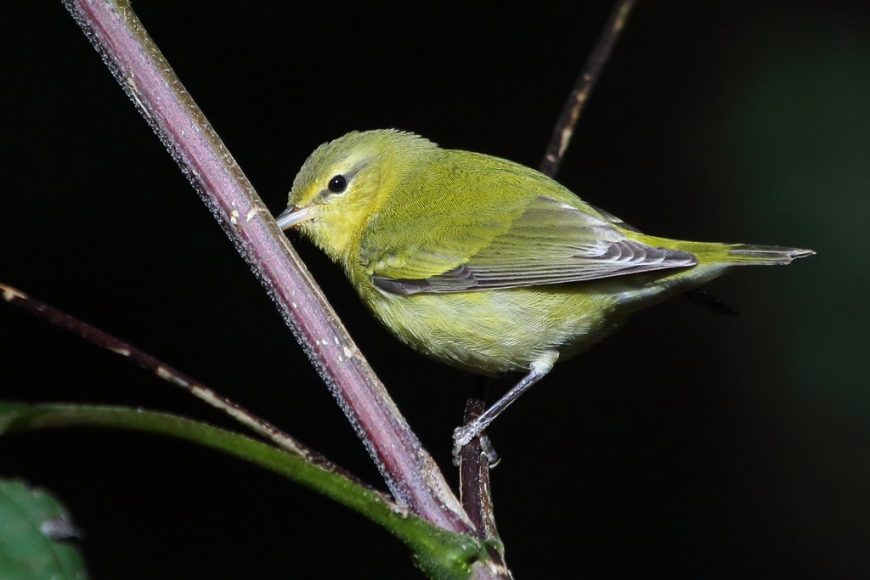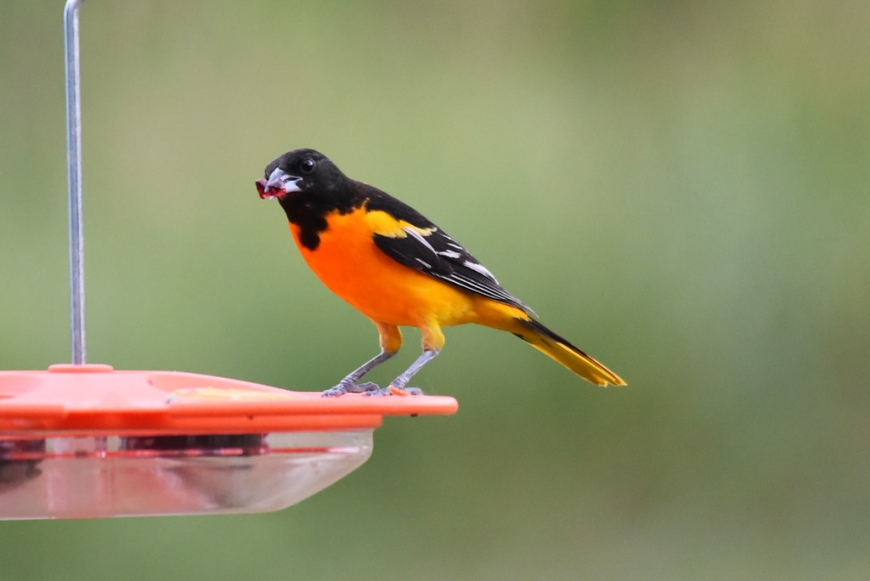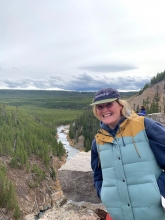


Black-throated blue warbler
Tennessee warbler
Baltimore oriole



The Invisible Songbird Serial Killer
We have officially reached the season many of us living in the North Country spend all year looking forward to: fall! This is the time of year that we all start to watch a variety of red, orange, and yellow leaves fly from tree branches and chevron after chevron of Canada geese flap their way south. The geese, honking from up above, call attention to themselves, piquing our interest and forcing our eyes upward. But have you ever noticed any smaller songbirds doing the same, fleeing the cold North Country autumn and seeking refuge for the winter? Not as large, and certainly not as loud, songbirds such as the Tennessee warbler, Baltimore oriole, and Black-throated blue warbler make their way south for the winter along with the geese. And as powerful as their wings are, all these birds face challenges on their journey south. Unfortunately, here at St. Lawrence University we have perpetuated yet another obstacle preventing them from making it home safely. What is this silent killer? Only our most “sustainable” buildings on campus!
What is Migration and why does it matter
Before we can understand the dangers of migration, we must have a clear understanding of what migration is, and why birds do it. Migration is an annual event that approximately half of the 650 North American breeding bird species participate in. This large-scale movement of birds between their breeding (summer) locations, and non-breeding (winter) locations is due to a search for resources. When the weather gets cold in the breeding regions food supply and nesting locations become scarce. By traveling south they can access an abundance of these resources. Migration can also be seen as a sort of a spectrum, some long-distance migrants will travel thousands of miles while short-distance migrants may only travel a hundred miles or less to their winter locations.
But how do our most sustainable buildings on campus impact this journey?
Birds already face dangers during migration such as: physical stress, bad weather, lack of food supplies, and exposure to predators. On top of these threats is the ever-growing danger presented by tall buildings, and the excessive use of windows on buildings. On the St. Lawrence University campus, we see these architectural elements on our newly constructed buildings such as Johnson Hall of Science and the Kirk Douglas residence hall. Both of these large buildings (which utilize sustainable aspects of LEED design) have large spans of windows that are proving to be a threat to the North Country’s migratory bird population. The irony is that it is in these buildings where students learn about the importance of biodiversity, the conservation of natural history, and the need to protect the natural heritage of the North Country.
So how are the buildings causing serial deaths for migrating birds?
Birds are attracted by lights illuminating buildings and deceived by the illusion of a clear window. They are then killed by striking these buildings at accelerated speeds. This occurs because birds can see through glass, and reflections within glass, but not the glass itself. This causes them to either think they are flying into the landscape beyond the building, the reflection behind the building, or even attacking their reflection, which appears to be another bird coming directly at them. Crashing into a building usually causes death on impact, although if they survive the impact the bird may fall to the ground stunned or injured, leaving them vulnerable to predators, or unable to recover from a major injury. This is exactly what we are seeing on campus buildings with large spans of windows, such as the Kirk Douglas bridge and the Johnson Hall of Science/ Bewkes Science Hall bridge, which are both constructed entirely from glass. Many students attuned to this problem have found species ranging from Brown-creepers, Dark-eyed juncos, and Tennessee warblers, dead or actively dying outside of these buildings on campus. Over the past few weeks 11 dead birds have been found by members of my Mist Nets and Museum Skins course on campus, this number only encompasses the birds we were able to find. Who knows how many migratory birds have experienced fatal injuries from window strikes? This not only increases migratory fatality within the entire population, but also creates hotspots for bird death within our campus community.
Why we care
The importance of caring about this danger to migratory birds, and the lives at stake, is rooted in the fact that birds, like all living beings, have intrinsic value and should be protected as citizens of the natural world. Beyond this basic truth, all bird’s species, but especially backyard songbirds, create direct links for human connection and participation within the natural world. Our want to observe and desire to be more like birds instills a greater connection to the natural world within children and adults alike. Their beautiful plumage, sweet songs, and lively character inspires our imagination and influences our art, music, writing, spirituality, design, and culture.
Birds not only influence our art and culture; they also boost people’s happiness. A study done in 2020 by the German Centre for Integrative Biodiversity Research found a positive correlation between the enjoyment of life and the presence of surrounding bird species. They said, “An additional 10% of bird species therefore increases the Europeans' life satisfaction as much as a comparable increase in income.” This point also speaks to the significance of biodiversity, and a birds’ ecological significance. Birds provide humans with a number of ecosystem services that we may not truly appreciate until they are gone. Birds pollinate plants, distribute seeds, and control pest populations, all of their own accord. This means that humans unknowingly benefit in a wide variety of ways from the services birds provide.
Solutions
It is important to note that this is not a problem without any solutions. The solutions are extensive, and can be implemented by both single-family residences as well as large commercial and institutional organizations. Here on campus, we are actively looking into the Acopian Birdsavers method which involves using “paracord” or parachute cord on the outside of the window so the birds can see the window and ultimately avoid it. Paracord is a thin nylon cord used in the suspension lines of parachutes and is great for this purpose because it prevents birds from hitting the windows and does not obstruct a person’s view from the inside. Birds see the paracord hanging from outside the window and realize the window is not a continuation of the landscape but rather a barrier, this allows them the opportunity to avoid the window before it is too late. These paracord lines also add a sense of relaxation from the inside of a home or building. Also called “Zen wind curtains” they hang vertically from the top of the window and are not secured to the bottom to allow them to blow in the wind. These lines are relatively low cost and can be easily installed by any homeowner. Other solutions that can be implemented at home or in commercial buildings include applying dense patterns or markings to large swaths of windows in your home. It is important that these markings are dense, of high contrast, are applied on the outside of the window, and cover the entire surface area of the window.
We are not alone here in the North County by trying to make our building environments safer for birds. Many organizations across the county and the world are also fighting to make migration safer. For example organizations such as FLAP Canada, Birdsafe, and the Lights Out project are all creating awareness and providing solutions for migratory birds. Check out the links below for some projects trying to assist migratory birds in their journey and ways to get involved!
Lights Out:
Birdsafe:
FLAP Canada:
Acopian Birdsavers

